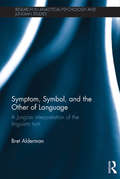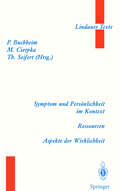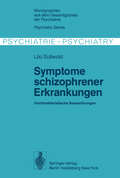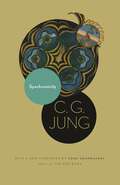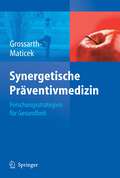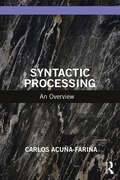- Table View
- List View
Symptom, Symbol, and the Other of Language: A Jungian Interpretation of the Linguistic Turn (Research in Analytical Psychology and Jungian Studies)
by Bret AldermanEvery statement about language is also a statement by and about psyche. Guided by this primary assumption, and inspired by the works of Carl Jung, in Symptom, Symbol, and the Other of Language, Bret Alderman delves deep into the symbolic and symptomatic dimensions of a deconstructive postmodernism infatuated with semiotics and the workings of linguistic signs. This book offers an important exploration of linguistic reference and representation through a Jungian understanding of symptom and symbol, using techniques including amplification, dream interpretation, and symbolic attitude. Focusing on Ferdinand de Saussure, Jacques Derrida, Michel Foucault, and Richard Rorty, Alderman examines the common belief that words and their meaning are grounded purely in language, instead envisioning a symptomatic expression of alienation and collective dissociation. Drawing upon the nascent field of ecopsychology, the modern disciplines of phenomenology and depth psychology, and the ancient knowledge of myth and animistic cosmologies, Alderman dares us to re-imagine some of the more sacrosanct concepts of the contemporary intellectual milieu informed by semiotics and the linguistic turn. Symptom, Symbol, and the Other of Language is essential reading for academics and students engaged in the study of depth psychology. However, the interdisciplinary approach of the work ensures that it will also be of great interest to those researching and studying in the areas of ethology, ecopsychology, philosophy, linguistics and mythology.
Symptom und Persönlichkeit im Kontext. Ressourcen. Aspekte der Wirklichkeit (Lindauer Texte)
by Peter Buchheim Manfred Cierpka T. SeifertSymptome schizophrener Erkrankungen: Uncharakteristische Basisstörungen (Monographien aus dem Gesamtgebiete der Psychiatrie #13)
by Lilo SüllwoldSymptoms and Signs of Substance Misuse
by Robert J. ParelliThe misuse of both legally prescribed and illegally supplied drugs is now so widespread that it affects, either directly or indirectly, a high proportion of the population, impacting many areas of daily life. There are few countries that are not touched by some aspect of substance misuse and the consequences for individuals, families and the wider
Synapse Development and Maturation: Comprehensive Developmental Neuroscience
by Bin Chen John Rubenstein Pasko Rakic Kenneth Y. Kwan Hollis T. Cline Jessica CardinSynapse Development and Maturation, the latest release in the Comprehensive Developmental Neuroscience series, presents the latest information on the genetic, molecular and cellular mechanisms of neural development. The book provides a much-needed update that underscores the latest research in this rapidly evolving field, with new section editors discussing the technological advances that are enabling the pursuit of new research on brain development. This volume focuses on the synaptogenesis and developmental sequences in the maturation of intrinsic and synapse-driven patterns.Features leading experts in various subfields as section editors and article authorsPresents articles that have been peer reviewed to ensure accuracy, thoroughness and scholarshipIncludes coverage of mechanisms which regulate synapse formation and maintenance during developmentCovers neural activity, from cell-intrinsic maturation, to early correlated patterns of activity
Synaptic Modification, Neuron Selectivity, and Nervous System Organization
by William B. Levy James A. Anderson Stephen LehmkuhleFirst published in 1985. Routledge is an imprint of Taylor & Francis, an informa company.
Synaptic Modification, Neuron Selectivity, and Nervous System Organization
by William B. Levy, James A. Anderson and Stephen LehmkuhleFirst published in 1985. Routledge is an imprint of Taylor & Francis, an informa company.
Synaptic Modulators (Handbook of Psychopharmacology #5)
by Leslie L. Iversen, Susan D. Iversen and Solomon H. SnyderSynaptic transfer (Large Print)
by Rnib BookshareThis diagram shows a cross section through a synaptic knob of a neuron, as it forms a synapse with another neuron. There is a locator dot shown, which will be at the top left of the page when the image is the right way up. There is a dashed image border around the diagram. A small branch of an axon starts at the centre left of the diagram and runs horizontally across the page, widening out at the end to form the synaptic knob. The textured area on the right of the diagram is the postsynaptic neuron, which is labelled. Between the postsynaptic neuron and the synaptic knob is the synaptic cleft. There are two calcium molecules to the top left of the synaptic knob. Next to them is the calcium gate. In the synaptic knob there are two vesicles, with neurotransmitter molecules in them. A vesicle has migrated to the right edge of the synaptic knob and burst. It is releasing neurotransmitter molecules which are going across the synaptic cleft. They will lodge in the postsynaptic receptors.
Synaptic transfer (UEB Contracted)
by Rnib BookshareThis diagram shows a cross section through a synaptic knob of a neuron, as it forms a synapse with another neuron. There is a locator dot shown, which will be at the top left of the page when the image is the right way up. There is a dashed image border around the diagram. A small branch of an axon starts at the centre left of the diagram and runs horizontally across the page, widening out at the end to form the synaptic knob. The textured area on the right of the diagram is the postsynaptic neuron, which is labelled. Between the postsynaptic neuron and the synaptic knob is the synaptic cleft. There are two calcium molecules to the top left of the synaptic knob. Next to them is the calcium gate. In the synaptic knob there are two vesicles, with neurotransmitter molecules in them. A vesicle has migrated to the right edge of the synaptic knob and burst. It is releasing neurotransmitter molecules which are going across the synaptic cleft. They will lodge in the postsynaptic receptors.
Synaptic transfer (UEB Uncontracted)
by Rnib BookshareThis diagram shows a cross section through a synaptic knob of a neuron, as it forms a synapse with another neuron. There is a locator dot shown, which will be at the top left of the page when the image is the right way up. There is a dashed image border around the diagram. A small branch of an axon starts at the centre left of the diagram and runs horizontally across the page, widening out at the end to form the synaptic knob. The textured area on the right of the diagram is the postsynaptic neuron, which is labelled. Between the postsynaptic neuron and the synaptic knob is the synaptic cleft. There are two calcium molecules to the top left of the synaptic knob. Next to them is the calcium gate. In the synaptic knob there are two vesicles, with neurotransmitter molecules in them. A vesicle has migrated to the right edge of the synaptic knob and burst. It is releasing neurotransmitter molecules which are going across the synaptic cleft. They will lodge in the postsynaptic receptors.
Synchronicity: An Acausal Connecting Principle
by C. G. JungTo Jung, synchonicity is a meaningful coincidence in time, a psychic factor which is independant of space and time. This revolutionary concept of synchronicity both challenges and complements the physicist's classical view of casualty. It also forces is to a basic reconsideration of the meaning of chance, probability, coincidence and the singular events in our lives.
Synchronicity: An Acausal Connecting Principle (Jung Extracts Ser. #598)
by C. G. JungTo Jung, synchonicity is a meaningful coincidence in time, a psychic factor which is independant of space and time. This revolutionary concept of synchronicity both challenges and complements the physicist's classical view of casualty. It also forces is to a basic reconsideration of the meaning of chance, probability, coincidence and the singular events in our lives.
Synchronicity: An Acausal Connecting Principle. (From Vol. 8. of the Collected Works of C. G. Jung)
by C. G. Jung R. F.C. Hull Sonu ShamdasaniJung was intrigued from early in his career with coincidences, especially those surprising juxtapositions that scientific rationality could not adequately explain. He discussed these ideas with Albert Einstein before World War I, but first used the term "synchronicity" in a 1930 lecture, in reference to the unusual psychological insights generated from consulting the I Ching. A long correspondence and friendship with the Nobel Prize-winning physicist Wolfgang Pauli stimulated a final, mature statement of Jung's thinking on synchronicity, originally published in 1952 and reproduced here. Together with a wealth of historical and contemporary material, this essay describes an astrological experiment Jung conducted to test his theory. Synchronicity reveals the full extent of Jung's research into a wide range of psychic phenomena. This paperback edition of Jung's classic work includes a new foreword by Sonu Shamdasani, Philemon Professor of Jung History at University College London.
Synchronicity: An Acausal Connecting Principle. (From Vol. 8. of the Collected Works of C. G. Jung)
by C. G. Jung R. F.C. Hull Sonu ShamdasaniJung was intrigued from early in his career with coincidences, especially those surprising juxtapositions that scientific rationality could not adequately explain. He discussed these ideas with Albert Einstein before World War I, but first used the term "synchronicity" in a 1930 lecture, in reference to the unusual psychological insights generated from consulting the I Ching. A long correspondence and friendship with the Nobel Prize-winning physicist Wolfgang Pauli stimulated a final, mature statement of Jung's thinking on synchronicity, originally published in 1952 and reproduced here. Together with a wealth of historical and contemporary material, this essay describes an astrological experiment Jung conducted to test his theory. Synchronicity reveals the full extent of Jung's research into a wide range of psychic phenomena. This paperback edition of Jung's classic work includes a new foreword by Sonu Shamdasani, Philemon Professor of Jung History at University College London.
Synchronicity: An Acausal Connecting Principle. (From Vol. 8. of the Collected Works of C. G. Jung)
by C. G. Jung Sonu Shamdasani R. F.C. HullJung was intrigued from early in his career with coincidences, especially those surprising juxtapositions that scientific rationality could not adequately explain. He discussed these ideas with Albert Einstein before World War I, but first used the term "synchronicity" in a 1930 lecture, in reference to the unusual psychological insights generated from consulting the I Ching. A long correspondence and friendship with the Nobel Prize-winning physicist Wolfgang Pauli stimulated a final, mature statement of Jung's thinking on synchronicity, originally published in 1952 and reproduced here. Together with a wealth of historical and contemporary material, this essay describes an astrological experiment Jung conducted to test his theory. Synchronicity reveals the full extent of Jung's research into a wide range of psychic phenomena. This paperback edition of Jung's classic work includes a new foreword by Sonu Shamdasani, Philemon Professor of Jung History at University College London.
Synchronicity as Transpersonal Modality: An Exploration of Jungian Spirituality in the Frame of Transrational Philosophy (Masters of Peace)
by Morten FrederiksenMorten Frederiksen explores Carl Gustav Jung’s elusive notion of synchronicity from a transrational perspective and relates synchronicity to the transpersonality of the "All-One". This is done by expanding the content and meaning of Wolfgang Dietrich´s layers of Elicitive Conflict Mapping (ECM) through re-relating them to Ken Wilber´s model of the structures of consciousness; with synchronicity as the literal connecting principle. The result, then, is an expanded notion of the transrational peace philosophy which includes Wilber´s model of stages shorn of its evolutionary slant and fathoms synchronicity in its theoretical outlook and practical application.
Syndrome der akuten Alkoholintoxikation und ihre forensische Bedeutung (Monographien aus dem Gesamtgebiete der Psychiatrie #39)
by Dieter AthenSynergetische Präventivmedizin: Strategien für Gesundheit
by Ronald Grossarth-MaticekIn diesem Buch werden wissenschaftliche Beweise über soziopsychobiologische Wechselwirkungen bei Entstehung chronischer Erkrankungen und Aufrechterhaltung der Gesundheit und Aktivität bis ins hohe Alter erbracht. Ebenso über die Wirksamkeit von präventiven Interventionen, die sich weitgehend auf Neugestaltung der Kommunikation in komplexen Systemen beziehen. Das Buch ist sowohl für Wissenschaftler unterschiedlicher Fachdisziplinen, die an einer komplexen Präventivmedizin interessiert sind, als auch für den Laien, der an neuen Erkenntnissen Interesse hat, geeignet. „..., weil es sich hier in vielen Punkten nicht nur um eine äußerst originelle Methodologie handelt, sondern um eine Methode, welche die weltweite Psychologie und Epidemiologie zur Weiterentwicklung anregen kann." – Prof. Dr. Werner Wittmann, Universität Mannheim, 2007.
Synesthesia: A Union of the Senses (Springer Series in Neuropsychology)
by Richard E. CytowicSynesthesia comes from the Greek syn (meaning union) and aisthesis (sensation), literally interpreted as a joining of the senses. Synesthesia is an involuntary joining in which the real information from one sense is joined or accompanies a perception in another. Dr. Cytowic reports extensive research into the physical, psychological, neural, and familial background of a group of synesthets. His findings form the first complete picture of the brain mechanisms that underlie this remarkable perceptual experience. His research demonstrates that this rare condition is brain-based and perceptual and not mind-based, as is the case with memory or imagery. Synesthesia offers a unique and detailed study of a condition which has confounded scientists for more than 200 years.
Synesthesia: Perspectives from Cognitive Neuroscience
by Lynn C. Robertson Noam SagivOwing to its bizarre nature and its implications for understanding how brains work, synesthesia has recently received a lot of attention in the popular press and motivated a great deal of research and discussion among scientists. The questions generated by these two communities are intriguing: Does the synesthetic phenomenon require awareness and attention? How does a feature that is not present become bound to one that is? Does synesthesia develop or is it hard wired? Should it change our way of thinking about perceptual experience in general? What is its value in understanding perceptual systems as a whole? This volume brings together a distinguished group of investigators from diverse backgrounds--among them neuroscientists, novelists, and synesthetes themselves--who provide fascinating answers to these questions. Although each approaches synesthesia from a very different perspective, and each was curious about and investigated synesthesia for very different reasons, the similarities between their work cannot be ignored. The research presented in this volume demonstrates that it is no longer reasonable to ask whether or not synesthesia is real--we must now ask how we can account for it from cognitive, neurobiological, developmental, and evolutionary perspectives. This book will be important reading for any scientist interested in brain and mind, not to mention synesthetes themselves, and others who might be wondering what all the fuss is about.
Synopsis of Sleep Medicine
by S. R. Pandi-PerumalSleep medicine encompasses an unusually board spectrum of contributions from biology, technology, and medicine. This volume summarizes the considerable mass of knowledge that has been accumulated in the field and imparts its major findings in a manner that is comprehensive yet not overwhelming. Edited by an eminent sleep researcher and with contributions from leading experts in the field, the volume provides a basic grounding in sleep medicine and covers the fascinating complexity of the field. It separates figure from ground for those who are newcomers to the field and who are seeking guideposts for further research. Sleep problems are frequently co-morbid with other medical conditions, and clinicians need to be alert to this interconnectedness and to recognize which difficulties are primary and which are not. Synoposis of Sleep Medicine will be a valuable tool for clinicians in many specialties for addressing diagnostic problems in sleep medicine. The volume is the first of its kind, rich yet comprehensive and focused and one that is sure to meet the needs of both basic and clinical research for some years to come.
Synopsis of Sleep Medicine
by S. R. Pandi-PerumalSleep medicine encompasses an unusually board spectrum of contributions from biology, technology, and medicine. This volume summarizes the considerable mass of knowledge that has been accumulated in the field and imparts its major findings in a manner that is comprehensive yet not overwhelming. Edited by an eminent sleep researcher and with contributions from leading experts in the field, the volume provides a basic grounding in sleep medicine and covers the fascinating complexity of the field. It separates figure from ground for those who are newcomers to the field and who are seeking guideposts for further research. Sleep problems are frequently co-morbid with other medical conditions, and clinicians need to be alert to this interconnectedness and to recognize which difficulties are primary and which are not. Synoposis of Sleep Medicine will be a valuable tool for clinicians in many specialties for addressing diagnostic problems in sleep medicine. The volume is the first of its kind, rich yet comprehensive and focused and one that is sure to meet the needs of both basic and clinical research for some years to come.
Syntactic Processing: An Overview
by Carlos Acuña-FariñaThis book provides an overview of the structures, topics and main theories of syntactic processing. It covers the last 40 years of sentence-level psycholinguistic research and debates and makes it accessible to both theoretical linguists and experimental psychologists. Tying linguistically relevant issues to psycholinguistic theory, this book: Covers the processing of the grammatical phenomena adjunction, agreement and gap filling and discusses the relationship between grammars and parsers Discusses experimental work and theories, demonstrating how psychologists have made real strides in understanding language and how studying the processing of syntactic structure is the same as studying the nature of language Explores the key theories of psycholinguistics, including recent developments Explains the different methodologies of sentence processing, such as eye-tracking and electroencephalography Bridging the gap between psycholinguistic research and the study of language, this book is essential reading for advanced students and scholars of linguistics and experimental psycholinguistics as well as cognitive science and psychology.
Syntactic Processing: An Overview
by Carlos Acuña-FariñaThis book provides an overview of the structures, topics and main theories of syntactic processing. It covers the last 40 years of sentence-level psycholinguistic research and debates and makes it accessible to both theoretical linguists and experimental psychologists. Tying linguistically relevant issues to psycholinguistic theory, this book: Covers the processing of the grammatical phenomena adjunction, agreement and gap filling and discusses the relationship between grammars and parsers Discusses experimental work and theories, demonstrating how psychologists have made real strides in understanding language and how studying the processing of syntactic structure is the same as studying the nature of language Explores the key theories of psycholinguistics, including recent developments Explains the different methodologies of sentence processing, such as eye-tracking and electroencephalography Bridging the gap between psycholinguistic research and the study of language, this book is essential reading for advanced students and scholars of linguistics and experimental psycholinguistics as well as cognitive science and psychology.
